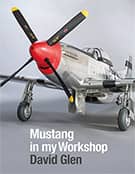Spitfire Mk IX Diary, page 7

Sunday, 29th May, 2016
My apologies for the lengthy hiatus in my web log, and particularly to those who have contacted me about it. I fear the cold, miserable...
Read more

Tuesday, 5th January, 2016
By mid-November I turned to the Spitfire’s side cowls, the easiest of the set in terms of their surface contours.
Work began with some localised repair...
Read more

Friday, 1st January, 2016
Sometime jobs go wrong, and sometimes they go badly wrong! Ever since finishing the ply-balsa fuselage core in 2013 I had pondered alternative ways to...
Read more

Thursday, 31st December, 2015
Shortly after installing the Vokes filter I made and fitted the strip of belly skin aft of it. It took several days because this elongated...
Read more

An experiment in panel beating
Wednesday, 30th December, 2015
I had long anticipated a major challenge when it came to the cowl panels. And as anticipated, I found it impossible to force litho plate...
Read more

Finishing the Vokes air intake
Wednesday, 30th December, 2015
A design feature of the Mk IX Spitfire is that its elegant, streamlined carburettor intake is constructed integral with the lower cowl, and that is...
Read more

Installing the upper sidewalls
Monday, 28th December, 2015
There are certain stages in the saga a scratch built model that change the landscape at a stroke. In the case of my Spitfire Mk...
Read more

Assembling the instrument faces
Sunday, 27th December, 2015
Rubdown stage
With the return of the custom dry transfer or ‘rubdown’ sheets assembly can get under way in earnest. Many aircraft instruments of the period...
Read more

Sunday, 27th December, 2015
My preferred technique for producing aircraft instrument faces (described in my book, Spitfire in my Workshop) relies on a device called a photo mechanical transfer...
Read more

Fitting out the instrument panel
Sunday, 27th December, 2015
If my woeful four-month long neglect of my diary has been noticed, then in mitigation I can at least claim to have been busy on...
Read more
Stories 61 to 70 of 125
Archive
- The sliding canopy frame
- Vac-forming the canopy
- Sliding canopy – the vac-form tool
- Installing the pilot's seat
- The pilot's seat completed
- Painting the rudder and elevators
- Empennage fixtures and fittings
- Rib stringing and taping
- Failed fabric
- 'Printed' pilot's seat
- Compass graphics assemblage
- Custom laser-cut rib tapes
- Empennage: The final details
- Warpaint: The squadron crest
- Warpaint: The 601 Sqn livery
- The Spitfire's tyres
- Machining the main landing wheels
- Fitting the exhaust stacks
- Leading edge wing root fillets
- Assembling the airscrew
- Skinning and fitting the ailerons
- Painting the exhaust stacks
- Undercarriage doors
- Rad cores and farings installed
- The radiator fairing doors
- Navigation lights installed
- A milestone – the wings completed!
- Return to action – the pitot tube
- Radiator fairings resumed
- Wing undersurfaces: Rad 'ramps'
- Wing undersurfaces: Riveting
- Wing undersurfaces: Gun covers
- Wing undersurfaces: Leading edge
- Top wing skin complete
- Some expert help
- Glaring error rectified
- Wing root fillets (upperside)
- Wing root fillets (underside)
- Wheel bay blisters
- Cannon blisters
- Blisters and cam-lock fasteners
- Finishing the flaps
- The wing tip skin
- Frog-eye nav light fairings
- Leading edge wing skin
- The gear strut channels
- Time to fit the wings
- The windscreen - Part 2
- The windscreen - Part 1
- The pilot's door
- Forgotten flaps – a remeidial task
- Lining and detailing the wheel wells
- The Spitfire's armament
- Horizontal stabiliser fillets
- Cladding the fin
- Cladding the stern section
- Installing the empennage
- Stabiliser Skin
- A second near disaster
- Cladding the fuselage
- Fuel tank cover
- The Spitfire's side cowls
- Top cowl and a major setback
- Belly skin and ident light
- An experiment in panel beating
- Finishing the Vokes air intake
- Installing the upper sidewalls
- Assembling the instrument faces
- Grapics for instrument faces
- Fitting out the instrument panel
- Fitting out the stbd upper sidewall
- Fitting out the port upper sidewall
- The chassis selector control
- The throttle quadrant
- Control column - Part 2
- Control column - Part 1
- Near disaster! A cautionary tale
- Fuse boxes and air filter control
- Magnetic compass and tray
- The instrument panel
- Upper cockpit walls
- Switch boxes and buttons
- Exhaust stack
- Oleo strut - Part 3
- Oleo strut - Part 2
- Oleo strut - Part 1
- The Spitfire's spinner
- Fitting out the port sidewall
- Filling gaps in the fuselage shell
- The seat support structure
- Head armour and volt regulator
- Fuel tank jettison controls
- The IFF switch assembly
- Oxygen and carbon dioxide
- Windscreen de-icing system
- Pneumatics 2: some ancillaries
- The rudder pedals
- The devil in the detail
- Rudder and elevator cables
- Pneumatic system 1: Air tanks
- Radiator fairings
- Empennage 2: The rudder
- Empennage 1: The elevators
- Casting the Vokes filter fairing
- Installing the nose section
- 'Sculpting' the wing root fairings
- Oleo strut supports
- Installing the wing centre section
- Wooden wing 2: underside
- Unexpected setback
- Wooden wing 1: topside
- Tail wheel and yoke
- Tail Strut
- An unsought interlude
- The built-up cockpit
- Plumbing preliminaries
- First internal skin panels
- Nose and fuselage balsa blocking
- Heel boards and rudder bars
- The visible fuselage frames
- Engineering or 'sleight of hand'?
- Fire bulkhead - first finished detail
- First cuts
- The planning stage
- Introduction

